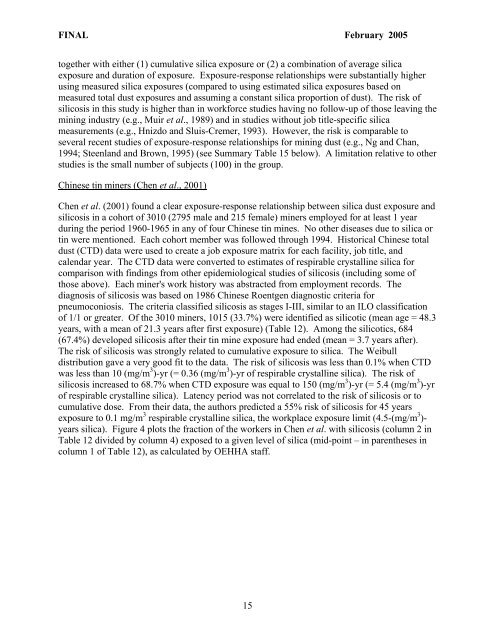Silica (crystalline, respirable) - OEHHA
Silica (crystalline, respirable) - OEHHA
Silica (crystalline, respirable) - OEHHA
You also want an ePaper? Increase the reach of your titles
YUMPU automatically turns print PDFs into web optimized ePapers that Google loves.
FINAL February 2005<br />
together with either (1) cumulative silica exposure or (2) a combination of average silica<br />
exposure and duration of exposure. Exposure-response relationships were substantially higher<br />
using measured silica exposures (compared to using estimated silica exposures based on<br />
measured total dust exposures and assuming a constant silica proportion of dust). The risk of<br />
silicosis in this study is higher than in workforce studies having no follow-up of those leaving the<br />
mining industry (e.g., Muir et al., 1989) and in studies without job title-specific silica<br />
measurements (e.g., Hnizdo and Sluis-Cremer, 1993). However, the risk is comparable to<br />
several recent studies of exposure-response relationships for mining dust (e.g., Ng and Chan,<br />
1994; Steenland and Brown, 1995) (see Summary Table 15 below). A limitation relative to other<br />
studies is the small number of subjects (100) in the group.<br />
Chinese tin miners (Chen et al., 2001)<br />
Chen et al. (2001) found a clear exposure-response relationship between silica dust exposure and<br />
silicosis in a cohort of 3010 (2795 male and 215 female) miners employed for at least 1 year<br />
during the period 1960-1965 in any of four Chinese tin mines. No other diseases due to silica or<br />
tin were mentioned. Each cohort member was followed through 1994. Historical Chinese total<br />
dust (CTD) data were used to create a job exposure matrix for each facility, job title, and<br />
calendar year. The CTD data were converted to estimates of <strong>respirable</strong> <strong>crystalline</strong> silica for<br />
comparison with findings from other epidemiological studies of silicosis (including some of<br />
those above). Each miner's work history was abstracted from employment records. The<br />
diagnosis of silicosis was based on 1986 Chinese Roentgen diagnostic criteria for<br />
pneumoconiosis. The criteria classified silicosis as stages I-III, similar to an ILO classification<br />
of 1/1 or greater. Of the 3010 miners, 1015 (33.7%) were identified as silicotic (mean age = 48.3<br />
years, with a mean of 21.3 years after first exposure) (Table 12). Among the silicotics, 684<br />
(67.4%) developed silicosis after their tin mine exposure had ended (mean = 3.7 years after).<br />
The risk of silicosis was strongly related to cumulative exposure to silica. The Weibull<br />
distribution gave a very good fit to the data. The risk of silicosis was less than 0.1% when CTD<br />
was less than 10 (mg/m 3 )-yr (= 0.36 (mg/m 3 )-yr of <strong>respirable</strong> <strong>crystalline</strong> silica). The risk of<br />
silicosis increased to 68.7% when CTD exposure was equal to 150 (mg/m 3 )-yr (= 5.4 (mg/m 3 )-yr<br />
of <strong>respirable</strong> <strong>crystalline</strong> silica). Latency period was not correlated to the risk of silicosis or to<br />
cumulative dose. From their data, the authors predicted a 55% risk of silicosis for 45 years<br />
exposure to 0.1 mg/m 3 <strong>respirable</strong> <strong>crystalline</strong> silica, the workplace exposure limit (4.5-(mg/m 3 )years<br />
silica). Figure 4 plots the fraction of the workers in Chen et al. with silicosis (column 2 in<br />
Table 12 divided by column 4) exposed to a given level of silica (mid-point – in parentheses in<br />
column 1 of Table 12), as calculated by <strong>OEHHA</strong> staff.<br />
15















